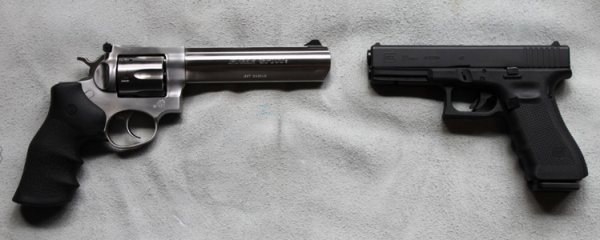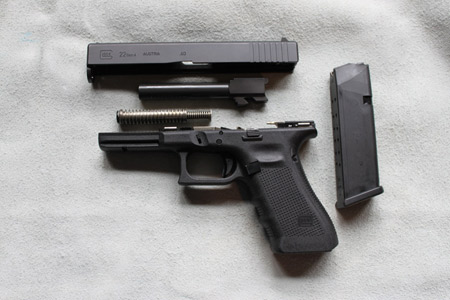Everyday Carry
By Robb Manning
Why Semi-Auto Handguns Are Better Than Revolvers: Semi-Auto myths dispelled
When it comes to pistols, we all have our preferences. Some love revolvers, while others prefer semi-autos. Just like how some people prefer to read their news on a computer or tablet, while some prefer to read the newspaper. One is not right or wrong, just different. The intent of this column is not to bash revolvers, but to dispel some myths about autos.
Time was, semi-autos were not as reliable as revolvers. All of what are now myths about the auto, were true. But that hasn’t been true for at least two decades now. Autos like the Beretta 92 and CZ-75 lead the way in fixing the deficiencies of the semi-auto, and companies like Glock, Smith & Wesson, FNH, Heckler & Koch and others have completely alleviated them.
Unfortunately, some are still perpetuating those myths. I was recently reading a magazine article (Building Your Survival Arsenal on Budget” by Ed Corcoran. Survivalist, Issue #2) and came across a very dated belief concerning autos. From the text:
I know some may disagree, but I recommend first getting a double-action revolver as a survival handgun. The reasons are basic reliability and simplicity. Sure, semi-automatic pistols can hold more rounds, are faster to load, and generally lighter and easier to conceal. But they’re also more complicated and high-maintenance -- prone to jams and feeding problems. They can also be finicky about the ammunition you use.

First off, just to refute the point that the first gun you should get is a revolver. Our first gun is not going to be a gun that we stow away for survival situations only. No, our first gun is our “do everything gun,” so you should really a get a gun that you’re going to use -- which most likely means a carry gun. Semi-auto handguns are, in general, easier to conceal for the novice. Further, in the type survival situation that the article addresses, if you are to need re-supply, ammunition found in semi-autos (9mm, .40 S&W, .45, etc) is going to be far more available than is revolver ammo (.38, .357, .41 magnum, etc) because those are the standards our military and police have used for decades.
As for the reasoning, I compare it to this statement: A horse is better because it’s simple to use and doesn’t require gas. Sure, a car goes faster, farther, allows you to carry more people and gear, but it’s more complicated and high-maintenance and prone to breaking down. Plus you have to use a certain kind of gas.
The holes in the logic are very similar. The benefits to items B (auto handgun and car), eclipse the benefits to items A (revolver and horse). Additionally, the negatives points listed for the semi-auto handgun are very dated and based on handgun designs from decades ago. None of that holds true anymore. Just like Vietnam veterans found the M16 to be unreliable, prone to jams and a hunk of plastic junk; none of that is true with today’s M16/M4/AR15. With modern plastics and using correct ammo (Vietnam era 5.56 ammo was incorrect for the M16, and the root cause of function issues) modern M16/ARs are the opposite of those things. Most of Mr. Corcoran’s arguments are based off of autos designed and made prior to around the 1970s, such as the 1911. Anyone who is familiar with modern semi-autos knows those things aren’t true.

Myth #1: Autos are not reliable.
I have spent all of my adult life around semi-autos. I carried the M9 for most of my nearly 11 years in the Marine Corps. It was my issued sidearm from the time I reached the rank of Corporal, until I got out. Almost all of my private collection of pistols are autos. Of the dozens of handguns I’ve tested as a writer, all but five were autos. It’s what I carry on me every day. With the exception of one handgun that had some design issues, I can count on one hand the number of failures I’ve had that weren’t issues of ammo defect.
Modern handguns -- especially polymer -- are extremely reliable, and companies like Glock specifically make their handguns to be reliable. Further, situations that could cause an auto to be unreliable -- i.e. desert sand -- would also cause a revolver to be inoperable. Get sand in a revolver’s cylinder and good luck with that. Plus, an auto is far easier to clear sand and debris from than a revolver. There’s very little you can do to a modern auto to make it not work. Glock has proven this. Drop a revolver or abuse the cylinder pivot assembly, it’s done. Revolver timing can be thrown off, and once it is, it’s useless until you take it to a gunsmith.
Mr. Corcoran said the semi-auto is “prone to jams and feeding problems.” Prone is defined as, “likely and/or probable.” So he’s saying, if I pick up a semi-auto and pull the trigger, it’s probably going to jam. That is likely the most ludicrous statement I’ve read. I have rarely had a jam or feeding problem Almost never. If you do, it’s not the end of the world -- it’s easy to fix.
He goes on to say if you have a misfire with a revolver, “...you can always pull the trigger again to cycle the cylinder to the next round.” He says, “If your semi-auto jams, you might as well throw the gun at your attacker and hope you clock him on the head.” Why anyone would throw a gun with a loaded magazine at an attacker is beyond me. With a revolver, if your first round fails, that means you only have 5 rounds left. If the first round in an auto fails, you will still have upwards of 15 rounds left. A better alternative to throwing it, is immediate action: Tap, Rack, Bang. Tap the magazine. Rack the slide. Pull the trigger. It takes less than a second, and you still have access to the ammo found in three revolvers.
Myth #2: Autos are more complicated than a revolver.
Revolvers are about as simple as a handmade Swiss movement in a timepiece. They might look simple, but that’s just because most of the parts are hidden. One of the autos with the fewest parts, the Glock, lists 35 parts. But this includes some parts listed as “assemblies,” which are comprised of multiple parts. If you break everything down completely, it is more likely around 42. The Springfield XD is around 50. The Ruger GP100 revolver has 71 parts listed and a Smith & Wesson 686 lists 86 parts. That’s definitely not more simple. A revolver has nearly twice as many parts that could potentially fail.
Aside from a parts count, here’s the difference. When you pull the trigger on an auto, it moves the striker/hammer to fire the pistol. When you pull the trigger on a revolver, it moves the hammer, as well as rotates the cylinder. Both most be perfectly timed or it doesn’t work. The action on a revolver is far more complicated. Plus, a broken part on an auto requires you to replace the part. A broken part on a revolver usually requires a gunsmith to replace the part and adjust the timing.
Semi-autos are definitely not more complicated than a revolver, but simplicity in itself does not necessarily mean better. A car from the 1950s is far simpler than one from 2013. But modern cars are safer, more reliable, more efficient, and can be driven for over 200,000 miles easy. My 2005 is just short of 100,000 miles and still feels new.
Myth #3: Autos are high Maintenance.
First off, cleaning a Glock is optional (I say this only half joking). You should probably punch the bore after firing, but not much else needed. I’ve seen Police turn-ins that look like they haven’t been cleaned since they were issued. Second, most modern polymer semi-autos break down into four or five parts. You have to punch the bore, remove fouling, and wipe it all down. If that’s high maintenance: Guilty as charged. I’ll give that the revolver is easier to clean, but you can’t exactly call a modern auto high maintenance.
Myth #4: Autos are finicky with ammo.
This dates back to early and mid era 1911s and autos designed when ball ammo was all you could find on the market. True, semi-autos could have the potential to be influenced by ammo, more so than revolvers. Autos are, after all, dependent on the firing of one round to cycle the action and chamber the next round. Revolvers do not depend on the firing of one round to chamber the next. Again, with the exception of the one handgun that had design issues, I haven’t had any ammo finickiness issues with any of my modern autos. My Glock eats anything, my Rugers eat anything, as does my M&P. Other than my .22s, older model 1911 (which doesn’t like hollow points) and the previously mentioned handgun (which only shoots premium ammo over 124 grs), none of my autos are finicky about ammo. In no way would I ever say an auto is finicky about ammo.
In sum, there are many myths out there about semi-autos that are simply not true. They started as fact a century ago with the first autos, and continued on over the decades. But it’s simply untrue about most semi-autos made after the 1970s or 80s, especially with modern polymer autos. Most people who have spent any time at all with autos realize this, because far more people carry autos than they do revolvers. I’m not saying revolvers aren’t great and they don’t have a place. I think they make excellent home defense guns. I think they are a great glovebox gun. I think they’re great in the woods -- hunting or critter-defense. For some people, revolvers are still the end-all, be-all, and that’s fine. Nothing wrong with that. Just don’t base that decision off of false-hoods about the semi-auto.









